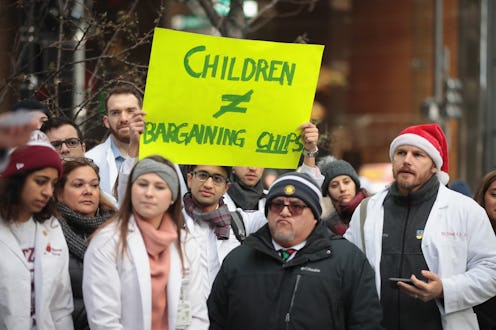News
This Is How CHIP Gets Its Funding In The First Place

Politico reported Thursday that Congress will attach a reauthorization of CHIP, the government program that provides health insurance to millions of low-income children, to its must-pass government funding bill. This is good news for supporters of CHIP, as the program's funding expired in September and Congress has been under tremendous pressure since to inject more money into it. But how does CHIP get funding in the first place?
It's simple: CHIP is funded by the federal government. Federal dollars pay for the program, which is why it's up to Congress to authorize funds to renew it.
Congress created CHIP, or Child's Health Insurance Program, in 1997 as part of the Balanced Budget Act. Like most federal programs, it's extraordinarily complex and nuanced piece of legislation, but the basics of how it works are pretty straightforward: Congress gives a lump sum of money to each state every year, and each state uses that money to pay for health care for its low-income children. The states have quite a bit of latitude in deciding how exactly to allocate its CHIP funds and which services it will cover.
All in all, the program provides health care to around 9 million American kids. Many have credited CHIP with reducing the uninsured rate among children from 14 percent in 1997 to just 4.5 percent in 2015.
But CHIP needs to be regularly re-funded in order to keep functioning, and the last time Congress did that was in 2015. The money from that last round of funding hasn't yet been depleted yet, but it soon will be: According to a Georgetown University study, two million American kids will lose their health insurance by January if CHIP isn't refunded before then, followed by millions of more losses over subsequent months.
Predicting exactly when CHIP funding will run out in any given state is impossible for a number of reasons, but Georgetown has identified the 18 states that are likely to exhaust their CHIP funding first.
Separate from all of this is the fact that Congress needs to pass a government funding bill by Friday in order to prevent a shutdown. In theory, this has nothing to do with CHIP. But Congressional Republicans refused to pass a CHIP reauthorization (or even put it up for a vote) at any point in 2017, and has apparently now decided that attaching a partial CHIP reauthorization to the government funding bill is the best way to inject money into the program before kids start losing their health care.
But the CHIP provision Republicans released Wednesday night is only a short-term fix. It funds the program for six months, but that six months is retroactive from September — so, really, it's a three-month reauthorization. That's certainly better than nothing, as it will stave off immediate disaster for those two million children who would otherwise lose their health care in January, but by March, those kids — and everyone who gets their health care from CHIP — will be in the exact same position they're in now.
However, it's possible that Congress will take another look at CHIP in mid-January, when the government funding bill the GOP just released expires. It's entirely possible that when Congress is crafting the next government funding bill, it will attach a more long-term CHIP reauthorization. One Republican in the House of Representatives expressed confidence that Congress will do exactly that.
“We’ve got to get this done and it will happen next month for sure, no question about it,” Rep. Fred Upton, who chairs the committee that overseas CHIP, told Politico. “I have no doubt — you can remind me of those words next month.”